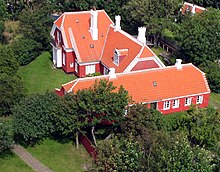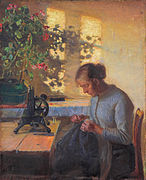Anna Ancher: Difference between revisions
m Reverted edits by Martinas41 (talk) to last revision by Oaktree b (HG) |
No edit summary |
||
| Line 1: | Line 1: | ||
[[Image:Anna Ancher, self-portrait, c. 1877–78.jpg|thumb|Anna Ancher, self-portrait, ca. 1877–78.]] |
[[Image:Anna Ancher, self-portrait, c. 1877–78.jpg|thumb|Anna Ancher, self-portrait, ca. 1877–78.]] |
||
'''Anna Ancher''' (18 August 1859 – 15 April 1935) was a Danish artist associated with the [[Skagen Painters]]. |
'''Anna Ancher''' (18 August 1859 – 15 April 1935) was a Danish{{flagicon|Denmark}} artist associated with the [[Skagen Painters]]. |
||
==Background== |
==Background== |
||
Revision as of 03:24, 9 October 2011

Anna Ancher (18 August 1859 – 15 April 1935) was a Danish![]() artist associated with the Skagen Painters.
artist associated with the Skagen Painters.
Background
Anna Kirstine Brøndum was born in Skagen, Denmark the daughter of Erik Andersen Brøndum (1820–1890) and Ane Hedvig Møller (1826-1916). Anna Ancher was the only one of the Skagen Painters who was actually born and grew up in this northernmost area of Jutland. Her father owned the Brøndums Hotel in Skagen. The artistic talent of Anna Ancher became obvious at an early age and she grew acquainted with pictorial art via the many artists who settled to paint in Skagen.

While she studied drawing for 3 years at the Vilhelm Kyhn College of Painting College of Painting in Copenhagen, she developed her own style and was a pioneer in observing the interplay of different colours in natural light. She also studied drawing in Paris at the atelier of Pierre Puvis de Chavannes along with Marie Triepcke, who would marry Peder Severin Krøyer, another Skagen painter. In 1880 she married fellow painter Michael Ancher, whom she met in Skagen. They had one daughter, Helga Ancher. Despite pressure from society that married women should devote themselves to household duties, she continued painting after marriage.[1]
Career
Anna Ancher is considered to be one of the great Danish pictorial artists by virtue of her abilities as a character painter and colourist[citation needed]. Her art found its expression in Nordic art's modern breakthrough towards a more truthful depiction of reality, e.g. in Blue Ane (1882) and The Girl in the Kitchen (1883–1886).[2]
Ancher preferred to paint interiors and simple themes from the everyday lives of the Skagen people and fishermen, women and children, and she was intensely preoccupied with exploring light and colour, e.g. Interior with Clematis (1913). She also created more complex compositions such as A Funeral (1891). Anna Ancher's works have often represented Danish art abroad. She was awarded the Ingenio et Arti medal in 1913[3] and the Tagea Brandt Rejselegat in 1924.
Michael and Anna Ancher's house

The Skagen residence of Anne and Michael Ancher was purchased in 1884. In 1913, a large studio annex was added to the property and this also forms part of what is on display today. Upon her death in 1964, the Ancher's daughter, Helga, left the house and all of its contents to a foundation. The former residence was restored and opened as a museum and visitor attraction.[4]
In 1967 Michael and Anna Ancher's house was turned into a museum by the Helga Ancher Foundation. Michael and Anna Ancher's house (Anchers Hus) in Skagen has been converted to a museum and is open to the public for tours. Original furniture and paintings created by the Anchers and other Skagen artists are shown in the restored home and studio. Art exhibitions are arranged in the Saxild House (Saxilds Gaard), another building on the property. This house is filled with displays of paintings by Michael and Anna Ancher as well as those from many other Skagen painters who made up their circle of friends.[5]
Danish thousand-kroner bill
Anna and Michael Ancher are currently featured on the front side of the DKK1000 bill. The current version of this bill came into circulation on 25 November 2004. The front of the banknote has a double portrait of Anna and Michael Ancher, derived from two 1884 paintings by Peder Severin Krøyer[6][7] which originally hung on the walls in the dining room at Brøndums Hotel.[citation needed]
Paintings
-
Syende fiskerpige (Sewing Fisherman's Wife, 1890)
-
Fru Ane Brøndum i den blå stue (Portrait of the Artist's Mother, 1913)
-
Solskin i den blå stue (Sunshine in the Blue Room, 1891)
-
Interiør med røde valmuer (Interior with poppies and reading woman, 1905)
See also
References
- ^ Ancher, Anna Kirstine (Dansk biografisk Lexikon)Danish
- ^ Anna Ancher (Et kunstnerhjem i Skagen)
- ^ "For videnskab og kunst medaljen Ingenio et arti". Litterære priser, medaljer, legater mv [Literary prizes, medals, scholarships, etc]. Retrieved 2010-09-05. List of recipients. Self-published, but with references Template:Da icon.
{{cite web}}: Unknown parameter|trans_title=ignored (|trans-title=suggested) (help)CS1 maint: postscript (link) - ^ Michael and Anna Ancher's House and Saxilds Gaard (Et kunstnerhjem i Skagen)
- ^ Anne and Michael Ancher’s house (Boboho Interior design Magazine)
- ^ The coins and banknotes of Denmark (PDF). Danmarks Nationalbank. 2005. pp. 22–23. ISBN 87-87251-55-8. Retrieved 6 September 2010.
- ^ "1,000-krone banknote, 1997 series". Danmarks Nationalbank. Retrieved 7 September 2010.




